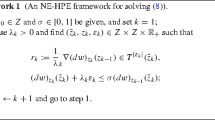Abstract
The Douglas–Rachford method is a popular splitting technique for finding a zero of the sum of two subdifferential operators of proper, closed, and convex functions and, more generally, two maximally monotone operators. Recent results concerned with linear rates of convergence of the method require additional properties of the underlying monotone operators, such as strong monotonicity and cocoercivity. In this paper, we study the case, when one operator is Lipschitz continuous but not necessarily a subdifferential operator and the other operator is strongly monotone. This situation arises in optimization methods based on primal–dual approaches. We provide new linear convergence results in this setting.


Similar content being viewed by others
Notes
This property also means that \(R_A\) is hypomonotone; see [11, Example 12.28].
This is also known as negative averagedness of the operator \(T_2T_1\) [20].
A closed function is also known as lower semicontinuous.
Here and elsewhere, we use \(f^{*}\) to denote the convex conjugate (this is also known as the Fenchel or Legendre conjugate) of f defined at \(u\in X\) as \(f^*(u) =\sup _{x\in X}\left\{ \langle u,x\rangle -f(x)\right\} \).
References
Lions, P.L., Mercier, B.: Splitting algorithms for the sum of two nonlinear operators. SIAM J. Numer. Anal. 16, 964–979 (1979)
Gabay, D.: Applications of the method of multipliers to variational inequalities. In: Fortin, M., Glowinski, R. (eds.) Augmented Lagrangian Methods: Applications to the Numerical Solution of Boundary-Value Problems, pp. 299–331. North-Holland, Amsterdam (1983)
Eckstein, J., Bertsekas, D.P.: On the Douglas–Rachford splitting method and the proximal point algorithm for maximal monotone operators. Math. Prog. 55, 293–318 (1992)
O’Connor, D., Vandenberghe, L.: On the equivalence of the primal-dual hybrid gradient method and Douglas–Rachford splitting. Math. Prog. Ser. A. https://doi.org/10.1007/s10107-018-1321-1
Bauschke, H.H., Combettes, P.L.: Convex Analysis and Monotone Operator Theory in Hilbert Spaces, 2nd edn. Springer, New York (2017)
Brezis, H.: Opérateurs Maximaux Monotones et Semi-Groupes de Contractions dans les Espaces de Hilbert. North-Holland/Elsevier, Amsterdam (1973)
Burachik, R.S., Iusem, A.N.: Set-Valued Mappings and Enlargements of Monotone Operators. Springer, New York (2008)
Combettes, P.L.: The convex feasibility problem in image recovery. Adv. Imag. Electron Phys. 25, 155–270 (1995)
Simons, S.: Minimax and Monotonicity. Springer, Berlin (1998)
Simons, S.: From Hahn–Banach to Monotonicity. Springer, Dordrecht (2008)
Rockafellar, R.T., Wets, R.J.-B.: Variational Analysis, 3rd edn. Springer, Berlin (2009)
Zeidler, E.: Nonlinear Functional Analysis and Its Applications II/A: Linear Monotone Operators. Springer, New York (1990)
Zeidler, E.: Nonlinear Functional Analysis and Its Applications II/B: Nonlinear Monotone Operators. Springer, New York (1990)
Borwein, J.M.: Fifty years of maximal monotonicity. Optim. Lett. 4, 473–490 (2010)
Ryu, E.K., Boyd, S.: A primer on monotone operator methods. Appl. Comput. Math. 15, 3–43 (2016)
Bauschke, H.H., Cruz, J.Y.B., Nghia, T.T.A., Phan, H.M., Wang, X.: The rate of linear convergence of the Douglas–Rachford algorithm for subspaces is the cosine of the Friedrichs angle. J. Approx. Theory 185, 63–79 (2014)
Bauschke, H.H., Moursi, W.M.: The Douglas–Rachford algorithm for two (not necessarily intersecting) affine subspaces. SIAM J. Optim. 26, 968–985 (2016)
Phan, H.M.: Linear convergence of the Douglas–Rachford method for two closed sets. Optimization 65, 36–385 (2016)
Lorenz, D.A., Tran-Dinh, Q.: Non-stationary Douglas–Rachford and alternating direction method of multipliers: adaptive stepsizes and convergence. arXiv:1801.03765
Giselsson, P.: Tight global linear convergence rate bounds for Douglas–Rachford splitting. J. Fixed Point Theory Appl. 19, 2241–2270 (2017)
Giselsson, P., Boyd, S.: Linear convergence and metric selection for Douglas–Rachford splitting and ADMM. IIEEE Trans. Autom. Control 62, 532–544 (2017)
Demanet, L., Zhang, X.: Eventual linear convergence of the Douglas–Rachford iteration for basis pursuit. Math. Comput. AMS 85, 209–238 (2015)
Liang, J., Fadili, J., Peyré, G.: Local convergence properties of Douglas–Rachford and alternating direction method of multipliers. J. Optim. Theory Appl. 172, 874–913 (2017)
Aspelmeier, T., Charitha, C., Luke, D.R.: Local linear convergence of the ADMM/Douglas–Rachford algorithms without strong convexity and application to statistical imaging. SIAM J. Imag. Sci. 9, 842–868 (2016)
Hesse, R., Luke, D.R.: Nonconvex notions of regularity and convergence of fundamental algorithms for feasibility problems. SIAM J. Optim. 23, 2397–2419 (2013)
Hesse, R., Luke, D.R., Neumann, P.: Alternating projections and Douglas–Rachford for sparse affine feasibility. IEEE Trans. Signal Proc. 62, 4868–4881 (2014)
Boţ, R.I., Hendrich, C.: A Douglas–Rachford type primal-dual method for solving inclusions with mixtures of composite and parallel-sum type monotone operators. SIAM J. Optim. 23, 2541–2565 (2013)
Briceño-Arias, L.M., Combettes, P.L.: A monotone + skew splitting model for composite monotone inclusions in duality. SIAM J. Optim. 21, 1230–1250 (2011)
Combettes, P.L., Pesquet, J.-C.: Primal-dual splitting algorithm for solving inclusions with mixtures of composite, Lipschitzian, and parallel-sum type monotone operators. Set Valued Var. Anal. 20, 307–330 (2012)
Condat, L.: A primal-dual splitting method for convex optimization involving Lipschitzian, proximable and linear composite terms. J. Optim. Theory Appl. 158, 460–479 (2013)
O’Connor, D., Vandenberghe, L.: Primal-dual decomposition by operator splitting and applications to image deblurring. SIAM J. Imag. Sc. 7, 1724–1754 (2014)
Combettes, P.L.: Solving monotone inclusions via compositions of nonexpansive averaged operators. Optimization 53, 475–504 (2004)
Svaiter, B.F.: On weak convergence of the Douglas–Rachford method. SIAM J. Control Optim. 49, 280–287 (2011)
Goebel, K., Kirk, W.A.: Topics in Metric Fixed Point Theory. Cambridge University Press, Cambridge (1990)
Wolfram Research, Inc., Mathematica, Version 11.3, Champaign, IL (2018)
Rockafellar, R.T.: On the maximal monotonicity of subdifferential mappings. Pac. J. Math. 33, 209–216 (1970)
Baillon, J.-B., Haddad, G.: Quelques propriétés des opérateurs angle-bornés et n-cycliquement monotones. Israel J. Math. 26, 137–150 (1977)
Bauschke, H.H., Combettes, P.L.: The Baillon–Haddad theorem revisited. J. Convex Anal. 17, 781–787 (2010)
Acknowledgements
This work was done while the authors were visiting the Simons Institute for the Theory of Computing. It was partially supported by the DIMACS/Simons Collaboration on Bridging Continuous and Discrete Optimization through NSF Grant # CCF-1740425.
Author information
Authors and Affiliations
Corresponding author
Additional information
Communicated by Jalal Fadili.
Publisher's Note
Springer Nature remains neutral with regard to jurisdictional claims in published maps and institutional affiliations.
Rights and permissions
About this article
Cite this article
Moursi, W.M., Vandenberghe, L. Douglas–Rachford Splitting for the Sum of a Lipschitz Continuous and a Strongly Monotone Operator. J Optim Theory Appl 183, 179–198 (2019). https://doi.org/10.1007/s10957-019-01517-8
Received:
Accepted:
Published:
Issue Date:
DOI: https://doi.org/10.1007/s10957-019-01517-8
Keywords
- Douglas–Rachford algorithm
- Linear convergence
- Lipschitz continuous mapping
- Skew-symmetric operator
- Strongly convex function
- Strongly monotone operator




